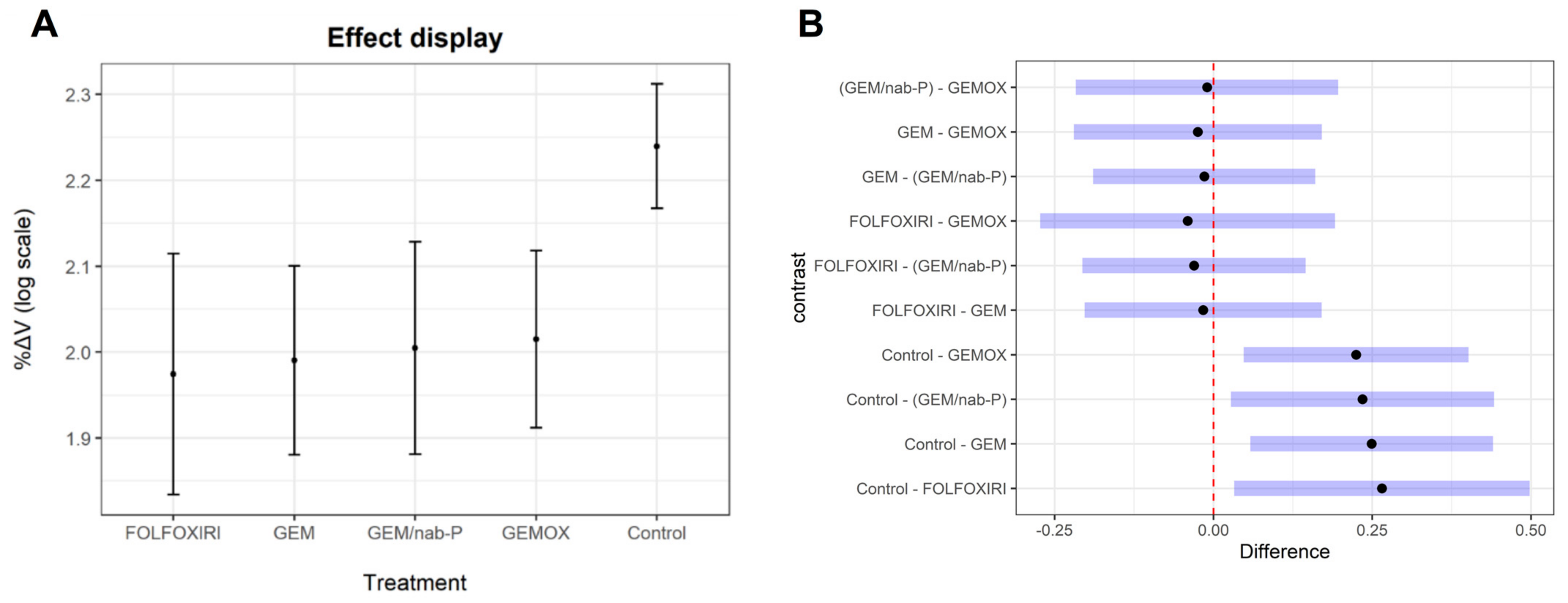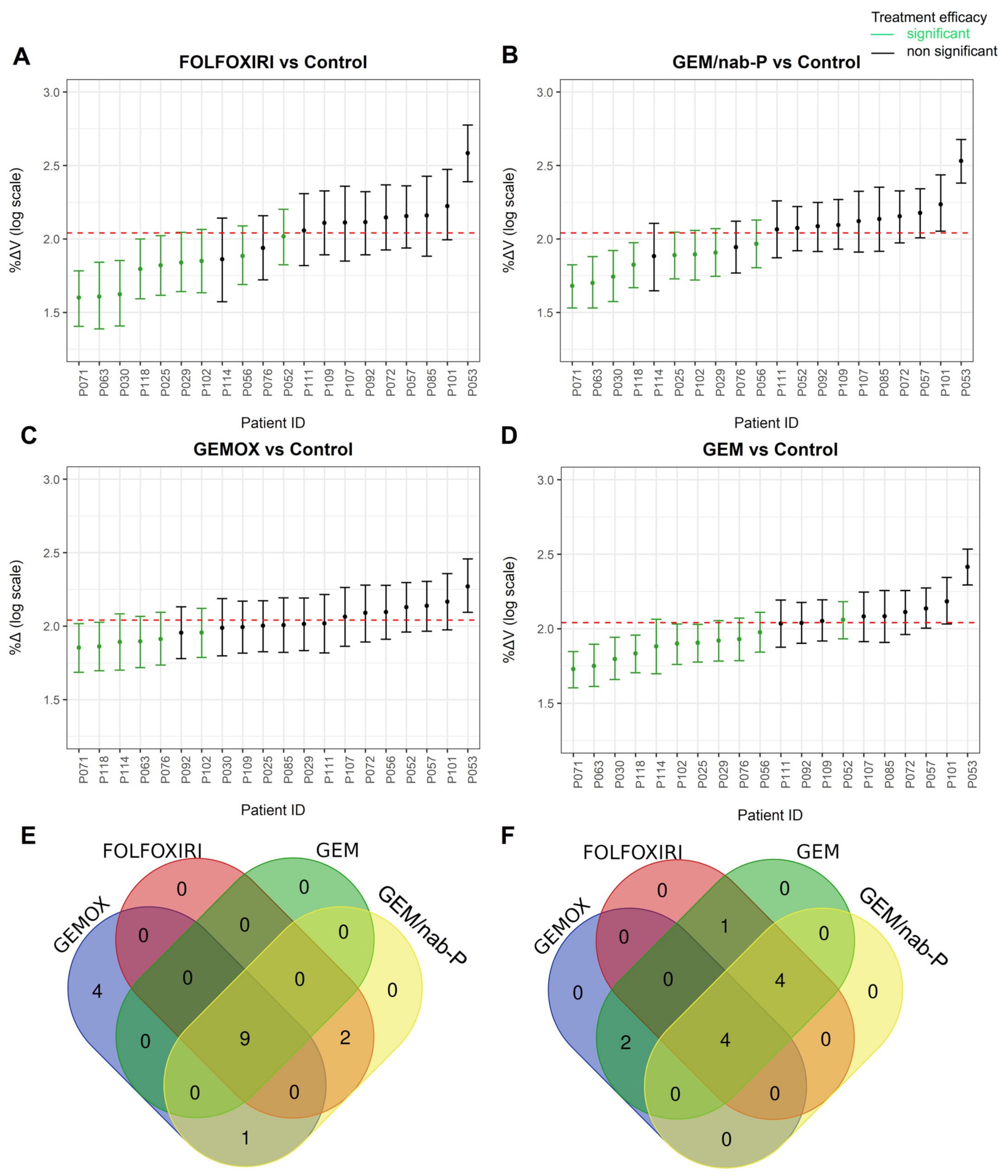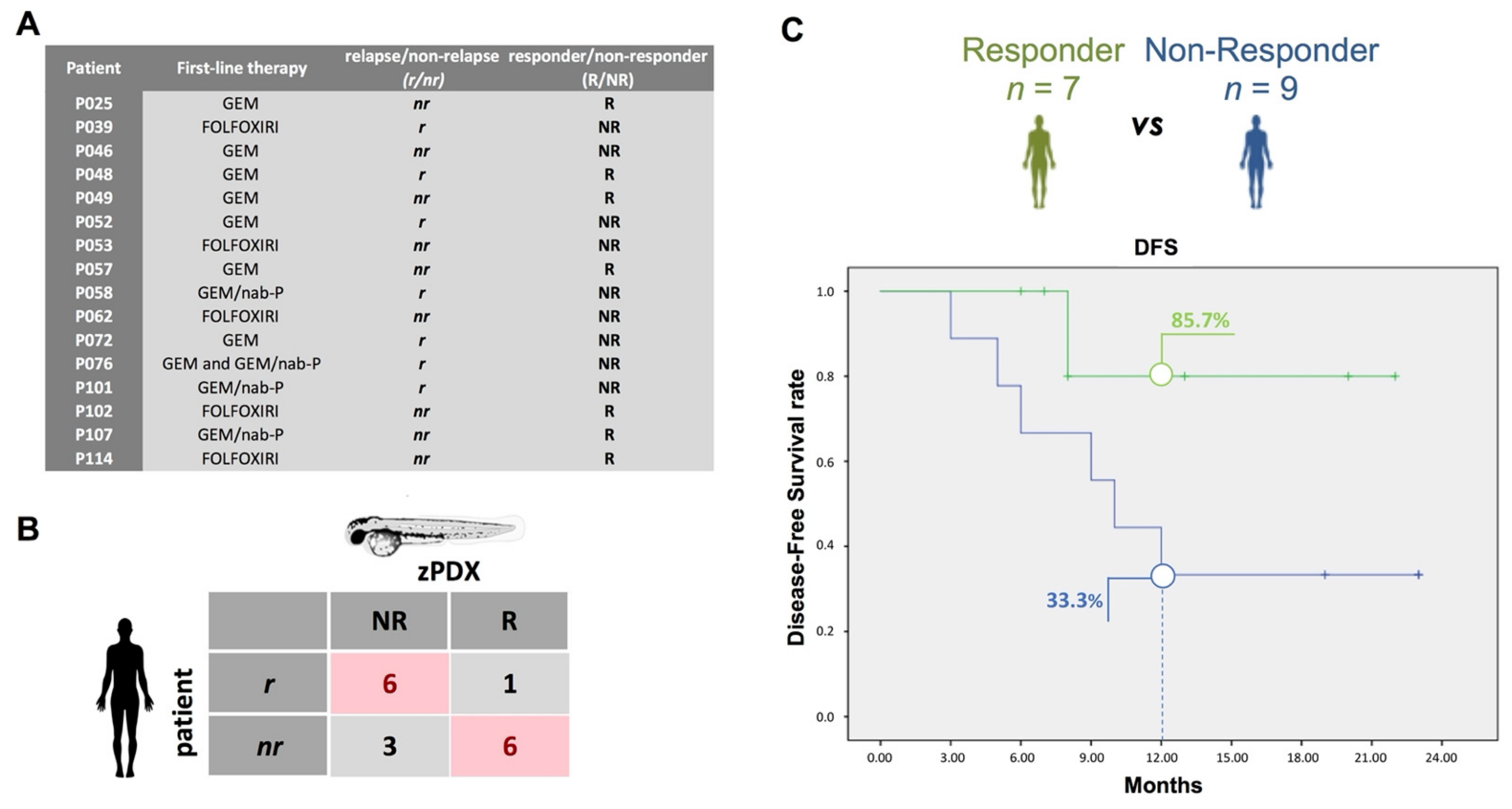Zebrafish Patient-Derived Xenografts Identify Chemo-Response in Pancreatic Ductal Adenocarcinoma Patients
Abstract
:Simple Summary
Abstract
1. Introduction
2. Results
2.1. Clinical Data of PDAC Patients
2.2. Zebrafish Trial
2.3. Data Modelling
2.4. Comparison of zPDX Drug Treatment with Short-Term Patient Treatment Responses
3. Discussion
4. Materials and Methods
4.1. Human Trial
4.2. Zebrafish Welfare Assurance and Husbandry
4.3. Human Material for Zebrafish Xenografts
4.4. Assessing Therapeutic Responses in Zebrafish Xenografts
4.5. Co-Clinical Trial
4.6. Linear Mixed Effect Model Data Analyses
5. Conclusions
Supplementary Materials
Author Contributions
Funding
Institutional Review Board Statement
Informed Consent Statement
Data Availability Statement
Conflicts of Interest
References
- Kleeff, J.; Korc, M.; Apte, M.; La Vecchia, C.; Johnson, C.D.; Biankin, A.V.; Neale, R.E.; Tempero, M.; Tuveson, D.A.; Hruban, R.H.; et al. Pancreatic cancer. Nat. Rev. Dis. Primers 2016, 2, 16022. [Google Scholar] [CrossRef]
- Bengtsson, A.; Andersson, R.; Ansari, D. The actual 5-year survivors of pancreatic ductal adenocarcinoma based on real-world data. Sci. Rep. 2020, 10, 16425. [Google Scholar] [CrossRef]
- Rahib, L.; Smith, B.D.; Aizenberg, R.; Rosenzweig, A.B.; Fleshman, J.M.; Matrisian, L.M. Projecting cancer incidence and deaths to 2030: The unexpected burden of thyroid, liver, and pancreas cancers in the United States. Cancer Res. 2014, 74, 2913–2921. [Google Scholar] [CrossRef] [Green Version]
- Guler, G.D.; Ning, Y.; Ku, C.J.; Phillips, T.; McCarthy, E.; Ellison, C.K.; Bergamaschi, A.; Collin, F.; Lloyd, P.; Scott, A.; et al. Detection of early stage pancreatic cancer using 5-hydroxymethylcytosine signatures in circulating cell free DNA. Nat. Commun. 2020, 11, 5270. [Google Scholar] [CrossRef]
- Adamska, A.; Domenichini, A.; Falasca, M. Pancreatic Ductal Adenocarcinoma: Current and Evolving Therapies. Int. J. Mol. Sci. 2017, 18, 1338. [Google Scholar] [CrossRef] [PubMed]
- Chand, S.; O’Hayer, K.; Blanco, F.F.; Winter, J.M.; Brody, J.R. The Landscape of Pancreatic Cancer Therapeutic Resistance Mechanisms. Int. J. Biol. Sci. 2016, 12, 273–282. [Google Scholar] [CrossRef] [Green Version]
- Hidalgo, M.; Cascinu, S.; Kleeff, J.; Labianca, R.; Löhr, J.M.; Neoptolemos, J.; Real, F.X.; Van Laethem, J.L.; Heinemann, V. Addressing the challenges of pancreatic cancer: Future directions for improving outcomes. Pancreatology 2015, 15, 8–18. [Google Scholar] [CrossRef]
- Tiriac, H.; Belleau, P.; Engle, D.D.; Plenker, D.; Deschênes, A.; Somerville, T.D.D.; Froeling, F.E.M.; Burkhart, R.A.; Denroche, R.E.; Jang, G.H.; et al. Organoid Profiling Identifies Common Responders to Chemotherapy in Pancreatic Cancer. Cancer Discov. 2018, 8, 1112–1129. [Google Scholar] [CrossRef] [PubMed] [Green Version]
- Huang, L.; Holtzinger, A.; Jagan, I.; BeGora, M.; Lohse, I.; Ngai, N.; Nostro, C.; Wang, R.; Muthuswamy, L.B.; Crawford, H.C.; et al. Ductal pancreatic cancer modeling and drug screening using human pluripotent stem cell- and patient-derived tumor organoids. Nat. Med. 2015, 21, 1364–1371. [Google Scholar] [CrossRef]
- Di Franco, G.; Usai, A.; Funel, N.; Palmeri, M.; Montesanti, I.E.R.; Bianchini, M.; Gianardi, D.; Furbetta, N.; Guadagni, S.; Vasile, E.; et al. Use of zebrafish embryos as avatar of patients with pancreatic cancer: A new xenotransplantation model towards personalized medicine. World J. Gastroenterol. 2020, 26, 2792–2809. [Google Scholar] [CrossRef] [PubMed]
- Wang, L.; Chen, H.; Fei, F.; He, X.; Sun, S.; Lv, K.; Yu, B.; Long, J.; Wang, X. Patient-derived Heterogeneous Xenograft Model of Pancreatic Cancer Using Zebrafish Larvae as Hosts for Comparative Drug Assessment. J. Vis. Exp. 2019, 146, 31107449. [Google Scholar] [CrossRef] [PubMed] [Green Version]
- Jung, J.; Lee, C.H.; Seol, H.S.; Choi, Y.S.; Kim, E.; Lee, E.J.; Rhee, J.K.; Singh, S.R.; Jun, E.S.; Han, B.; et al. Generation and molecular characterization of pancreatic cancer patient-derived xenografts reveals their heterologous nature. Oncotarget 2016, 7, 62533–62546. [Google Scholar] [CrossRef] [Green Version]
- Li, S.; Shen, D.; Shao, J.; Crowder, R.; Liu, W.; Prat, A.; He, X.; Liu, S.; Hoog, J.; Lu, C.; et al. Endocrine-therapy-resistant ESR1 variants revealed by genomic characterization of breast-cancer-derived xenografts. Cell Rep. 2013, 4, 1116–1130. [Google Scholar] [CrossRef] [Green Version]
- Wu, J.Q.; Zhai, J.; Li, C.Y.; Tan, A.M.; Wei, P.; Shen, L.Z.; He, M.F. Patient-derived xenograft in zebrafish embryos: A new platform for translational research in gastric cancer. J. Exp. Clin. Cancer Res. 2017, 36, 160. [Google Scholar] [CrossRef] [PubMed] [Green Version]
- Chou, J.; Fitzgibbon, M.P.; Mortales, C.L.; Towlerton, A.M.; Upton, M.P.; Yeung, R.S.; McIntosh, M.W.; Warren, E.H. Phenotypic and transcriptional fidelity of patient-derived colon cancer xenografts in immune-deficient mice. PLoS ONE 2013, 8, e79874. [Google Scholar] [CrossRef]
- Guo, M.; Wei, H.; Hu, J.; Sun, S.; Long, J.; Wang, X. U0126 inhibits pancreatic cancer progression via the KRAS signaling pathway in a zebrafish xenotransplantation model. Oncol. Rep. 2015, 34, 699–706. [Google Scholar] [CrossRef] [PubMed] [Green Version]
- Xiao, J.; Glasgow, E.; Agarwal, S. Zebrafish Xenografts for Drug Discovery and Personalized Medicine. Trends Cancer 2020, 6, 569–579. [Google Scholar] [CrossRef]
- Tentler, J.J.; Tan, A.C.; Weekes, C.D.; Jimeno, A.; Leong, S.; Pitts, T.M.; Arcaroli, J.J.; Messersmith, W.A.; Eckhardt, S.G. Patient-derived tumour xenografts as models for oncology drug development. Nat. Rev. Clin. Oncol. 2012, 9, 338–350. [Google Scholar] [CrossRef] [Green Version]
- Hidalgo, M.; Amant, F.; Biankin, A.V.; Budinská, E.; Byrne, A.T.; Caldas, C.; Clarke, R.B.; de Jong, S.; Jonkers, J.; Mælandsmo, G.M.; et al. Patient-derived xenograft models: An emerging platform for translational cancer research. Cancer Discov. 2014, 4, 998–1013. [Google Scholar] [CrossRef] [Green Version]
- Goto, T. Patient-Derived Tumor Xenograft Models: Toward the Establishment of Precision Cancer Medicine. J. Pers. Med. 2020, 10, 64. [Google Scholar] [CrossRef]
- Huch, M.; Knoblich, J.A.; Lutolf, M.P.; Martinez-Arias, A. The hope and the hype of organoid research. Development 2017, 144, 938–941. [Google Scholar] [CrossRef] [Green Version]
- Fazio, M.; Ablain, J.; Chuan, Y.; Langenau, D.M.; Zon, L.I. Zebrafish patient avatars in cancer biology and precision cancer therapy. Nat. Rev. Cancer 2020, 20, 263–273. [Google Scholar] [CrossRef]
- Usai, A.; Di Franco, G.; Colucci, P.; Pollina, L.E.; Vasile, E.; Funel, N.; Palmeri, M.; Dente, L.; Falcone, A.; Morelli, L.; et al. A Model of a Zebrafish Avatar for Co-Clinical Trials. Cancers 2020, 12, 677. [Google Scholar] [CrossRef] [Green Version]
- Brunner, M.; Wu, Z.; Krautz, C.; Pilarsky, C.; Grützmann, R.; Weber, G.F. Current Clinical Strategies of Pancreatic Cancer Treatment and Open Molecular Questions. Int. J. Mol. Sci. 2019, 20, 4543. [Google Scholar] [CrossRef] [Green Version]
- Fischer, R.; Breidert, M.; Keck, T.; Makowiec, F.; Lohrmann, C.; Harder, J. Early recurrence of pancreatic cancer after resection and during adjuvant chemotherapy. Saudi J. Gastroenterol. 2012, 18, 118–121. [Google Scholar] [CrossRef]
- Matsumoto, I.; Murakami, Y.; Shinzeki, M.; Asari, S.; Goto, T.; Tani, M.; Motoi, F.; Uemura, K.; Sho, M.; Satoi, S.; et al. Proposed preoperative risk factors for early recurrence in patients with resectable pancreatic ductal adenocarcinoma after surgical resection: A multi-center retrospective study. Pancreatology 2015, 15, 674–680. [Google Scholar] [CrossRef]
- Von Hoff, D.D.; Ervin, T.; Arena, F.P.; Chiorean, E.G.; Infante, J.; Moore, M.; Seay, T.; Tjulandin, S.A.; Ma, W.W.; Saleh, M.N.; et al. Increased survival in pancreatic cancer with nab-paclitaxel plus gemcitabine. N. Engl. J. Med. 2013, 369, 1691–1703. [Google Scholar] [CrossRef] [PubMed] [Green Version]
- Conroy, T.; Desseigne, F.; Ychou, M.; Bouché, O.; Guimbaud, R.; Bécouarn, Y.; Adenis, A.; Raoul, J.L.; Gourgou-Bourgade, S.; de la Fouchardière, C.; et al. FOLFIRINOX versus gemcitabine for metastatic pancreatic cancer. N. Engl. J. Med. 2011, 364, 1817–1825. [Google Scholar] [CrossRef] [PubMed] [Green Version]
- Abbruzzese, J.L.; Hess, K.R. New option for the initial management of metastatic pancreatic cancer? J. Clin. Oncol. 2014, 32, 2405–2407. [Google Scholar] [CrossRef] [Green Version]
- Verma, M. Personalized medicine and cancer. J. Pers. Med. 2012, 2, 1–14. [Google Scholar] [CrossRef] [PubMed] [Green Version]
- Krzyszczyk, P.; Acevedo, A.; Davidoff, E.J.; Timmins, L.M.; Marrero-Berrios, I.; Patel, M.; White, C.; Lowe, C.; Sherba, J.J.; Hartmanshenn, C.; et al. The growing role of precision and personalized medicine for cancer treatment. Technology 2018, 6, 79–100. [Google Scholar] [CrossRef] [PubMed] [Green Version]
- Costa, B.; Estrada, M.F.; Mendes, R.V.; Fior, R. Zebrafish Avatars towards Personalized Medicine-A Comparative Review between Avatar Models. Cells 2020, 9, 293. [Google Scholar] [CrossRef] [PubMed] [Green Version]
- Byrne, A.T.; Alférez, D.G.; Amant, F.; Annibali, D.; Arribas, J.; Biankin, A.V.; Bruna, A.; Budinská, E.; Caldas, C.; Chang, D.K.; et al. Interrogating open issues in cancer precision medicine with patient-derived xenografts. Nat. Rev. Cancer 2017, 17, 254–268. [Google Scholar] [CrossRef]
- Hason, M.; Bartůněk, P. Zebrafish Models of Cancer-New Insights on Modeling Human Cancer in a Non-Mammalian Vertebrate. Genes 2019, 10, 935. [Google Scholar] [CrossRef] [Green Version]
- Lieschke, G.J.; Currie, P.D. Animal models of human disease: Zebrafish swim into view. Nat. Rev. Genet. 2007, 8, 353–367. [Google Scholar] [CrossRef]
- Haldi, M.; Ton, C.; Seng, W.L.; McGrath, P. Human melanoma cells transplanted into zebrafish proliferate, migrate, produce melanin, form masses and stimulate angiogenesis in zebrafish. Angiogenesis 2006, 9, 139–151. [Google Scholar] [CrossRef] [PubMed]
- Dauer, P.; Nomura, A.; Saluja, A.; Banerjee, S. Microenvironment in determining chemo-resistance in pancreatic cancer: Neighborhood matters. Pancreatology 2017, 17, 7–12. [Google Scholar] [CrossRef] [Green Version]
- Neesse, A.; Michl, P.; Frese, K.K.; Feig, C.; Cook, N.; Jacobetz, M.A.; Lolkema, M.P.; Buchholz, M.; Olive, K.P.; Gress, T.M.; et al. Stromal biology and therapy in pancreatic cancer. Gut 2011, 60, 861–868. [Google Scholar] [CrossRef]
- Weniger, M.; Honselmann, K.C.; Liss, A.S. The Extracellular Matrix and Pancreatic Cancer: A Complex Relationship. Cancers 2018, 10, 316. [Google Scholar] [CrossRef] [PubMed] [Green Version]
- Stopa, K.B.; Kusiak, A.A.; Szopa, M.D.; Ferdek, P.E.; Jakubowska, M.A. Pancreatic Cancer and Its Microenvironment-Recent Advances and Current Controversies. Int. J. Mol. Sci. 2020, 21, 3218. [Google Scholar] [CrossRef]
- Fior, R.; Póvoa, V.; Mendes, R.V.; Carvalho, T.; Gomes, A.; Figueiredo, N.; Ferreira, M.G. Single-cell functional and chemosensitive profiling of combinatorial colorectal therapy in zebrafish xenografts. Proc. Natl. Acad. Sci. USA 2017, 114, E8234–E8243. [Google Scholar] [CrossRef] [PubMed] [Green Version]
- Georgakopoulos, N.; Prior, N.; Angres, B.; Mastrogiovanni, G.; Cagan, A.; Harrison, D.; Hindley, C.J.; Arnes-Benito, R.; Liau, S.S.; Curd, A.; et al. Long-term expansion, genomic stability and in vivo safety of adult human pancreas organoids. BMC Dev. Biol. 2020, 20, 4. [Google Scholar] [CrossRef] [Green Version]
- Weibel, P.; Pavic, M.; Lombriser, N.; Gutknecht, S.; Weber, M. Chemoradiotherapy after curative surgery for locally advanced pancreatic cancer: A 20-year single center experience. Surg. Oncol. 2021, 36, 36–41. [Google Scholar] [CrossRef] [PubMed]
- Turpin, A.; El Amrani, M.; Bachet, J.B.; Pietrasz, D.; Schwarz, L.; Hammel, P. Adjuvant Pancreatic Cancer Management: Towards New Perspectives in 2021. Cancers 2020, 12, 3866. [Google Scholar] [CrossRef] [PubMed]
- Lee, K.H.; Chie, E.K.; Im, S.A.; Kim, J.H.; Kwon, J.; Han, S.W.; Oh, D.Y.; Jang, J.Y.; Kim, J.S.; Kim, T.Y.; et al. Phase II Trial of Postoperative Adjuvant Gemcitabine and Cisplatin Chemotherapy Followed by Chemoradiotherapy with Gemcitabine in Patients with Resected Pancreatic Cancer. Cancer Res. Treat. 2020, 33421976. [Google Scholar] [CrossRef]
- Amin, M.B.; Greene, F.L.; Edge, S.B.; Compton, C.C.; Gershenwald, J.E.; Brookland, R.K.; Meyer, L.; Gress, D.M.; Byrd, D.R.; Winchester, D.P. The Eighth Edition AJCC Cancer Staging Manual: Continuing to build a bridge from a population-based to a more “personalized” approach to cancer staging. CA Cancer J. Clin. 2017, 67, 93–99. [Google Scholar] [CrossRef]
- Kimmel, C.B.; Ballard, W.W.; Kimmel, S.R.; Ullmann, B.; Schilling, T.F. Stages of embryonic development of the zebrafish. Dev. Dyn. 1995, 203, 253–310. [Google Scholar] [CrossRef]
- World Health Organization. WHO Handbook for Reporting Results of Cancer Treatment; World Health Organization: Geneva, Switzerland, 1979; p. 45. [Google Scholar]
- Zuur, A.; Ieno, E.N.; Walker, N.; Saveliev, A.A.; Smith, G.M. Mixed Effects Models and Extensions in Ecology with R, 1st ed.; Springer: New York, NY, USA, 2009. [Google Scholar]
- Fox, J. Applied Regression Analysis and Generalized Linear Models, 3rd ed.; SAGE: Los Angeles, CA, USA; London, UK, 2016; p. 791. [Google Scholar]




| Characteristics | |
|---|---|
| Mean age, years ± SD | 71.8 ± 8.2 (44–85) |
| M:F, n (%) | 18:13 (58.1%) |
| Mean BMI, kg/m2 ± SD | 25.5 ± 4.4 (17.6–40.4) |
| Type of surgical procedure, n (%) | |
| Pancreatoduodenectomy | 23 (74.2%) |
| Distal splenopancreatectomy | 7 (22.6%) |
| Total splenopancreatectomy | 1 (3.2%) |
| Vascular resection, n (%) | 3 (9.7%) |
| Grade of differentiation, n (%) | |
| G2/3 | 23 (74.2%) |
| G3/3 | 8 (25.8%) |
| Mean tumor dimension, cm | 3.2 ± 1.0 (1.5–5.0) |
| Mean harvest lymph nodes, n | 39.5 ± 16.6 (17–74) |
| Mean positive lymph nodes, n | 5.2 ± 4.7 (0–22) |
| T status, n (%) | |
| T1 | 3 (9.7%) |
| T2 | 19 (63.3%) |
| T3 | 9 (30.0%) |
| N status, n (%) | |
| N0 | 2 (6.5%) |
| N1 | 12 (38.7%) |
| N2 | 17 (54.8%) |
| Stage, n (%) | |
| IA | 1 (3.2%) |
| IB | 1 (3.2%) |
| IIB | 12 (38.7%) |
| III | 16 (51.6%) |
| IV | 1 (3.2%) |
| Angioinvasion, n (%) | 3 (9.7%) |
| Perineural infiltration, n (%) | 24 (77.4%) |
| Vascular infiltration, n (%) | 2 (6.7%) |
| Characteristics | Responder (n = 7) | Non-Responder (n = 9) | p Value |
|---|---|---|---|
| Mean age, years ± SD | 71.4 ± 5.3 | 67.9 ± 11.0) | 0.448 |
| M:F, n (%) | 2:5 (28.6%:71.4%) | 7:2 (77.8%:22.2%) | 0.049 |
| Mean BMI, kg/m2 ± SD | 26.3 ± 6.7 | 24.4 ± 3.1 | 0.448 |
| Type of surgical procedure, n (%) | 0.091 | ||
| Pancreatoduodenectomy | 6 (85.7%) | 4 (44.4%) | |
| Distal splenopancreatectomy | 1 (14.3%) | 5 (55.6%) | |
| Vascular resection, n (%) | 0 | 1 (11.1%) | 0.362 |
| Grade of differentiation, n (%) | 0.042 | ||
| G2/3 | 7 (100%) | 5 (55.6%) | |
| G3/3 | 0 | 4 (44.4%) | |
| Mean tumor dimension, cm | 2.9 ± 0.5 | 3.4 ± 1.1 | 0.209 |
| Mean harvest lymph nodes, n | 41.1 ± 21.6 | 38.7 ± 18.8 | 0.810 |
| Mean positive lymph nodes, n | 5.0 ± 3.6 | 5.4 ± 4.0 | 0.820 |
| T status, n (%) | 0.059 | ||
| T1 | 0 | 1 (11.1%) | |
| T2 | 7 (100%) | 4 (44.4%) | |
| T3 | 0 | 4 (44.4%) | |
| N status, n (%) | 0.949 | ||
| N1 | 3 (42.9%) | 4 (44.4%) | |
| N2 | 4 (57.1%) | 5 (55.6%) | |
| Stage, n (%) | 0.635 | ||
| IIB | 3 (42.9%) | 4 (44.4%) | |
| III | 4 (57.1%) | 4 (44.4%) | |
| IV | 0 | 1 (11.1%) | |
| Angioinvasion, n (%) | 0 | 1 (11.1%) | 0.362 |
| Perineural infiltration, n (%) | 5 (71.4%) | 6 (66.7%) | 0.838 |
| Vascular infiltration, n (%) | 0 | 0 | 1 |
| Type of adjuvant chemotherapy schemes, n (%) | 0.574 | ||
| Gemcitabine | 4 (57.1%) | 3 (33.3%) | |
| GEM/nab-P | 1 (14.3%) | 3 (33.3%) | |
| FOLFOXIRI | 2 (28.6%) | 3 (33.3%) | |
| Cancer recurrence, n (%) | 1 (14.3%) | 6 (66.7%) | 0.036 |
| DFS, mean (months) | 19.2 ± 2.5 | 12.7 ± 2.6 | 0.125 |
| Follow Up, mean (months) | 13.9 ± 7.1 | 17.6 ± 6.8 | 0.305 |
| Chemotherapy Protocol | Drugs Combination | Concentration (mg/mL) |
|---|---|---|
| Gemcitabine | Gemcitabine | 0.067 |
| GEMOX | Gemcitabine | 0.067 |
| Oxaliplatin | 0.007 | |
| GEM/nab-P | Gemcitabine | 0.067 |
| nab-Paclitaxel | 0.008 | |
| FOLFOXIRI | 5-Fluorouracil | 0.216 |
| Folinic acid | 0.013 | |
| Oxaliplatin | 0.006 | |
| Irinotecan | 0.011 |
| Progressive Disease (PD) | Increase ≥ 25% in the relative stained area at 2 dpi |
| Stable Disease (SD) | Decrease or increase < 25% in the relative stained area at 2 dpi |
| Minor Response (MR) | Decrease ≥ 25% but < 50% in the relative stained area at 2 dpi |
| Partial Response (PR) | Decrease ≥ 50% but < 90% in the relative stained area at 2 dpi |
| Complete Response (CR) | Decrease ≥ 90% in the relative stained area at 2 dpi |
Publisher’s Note: MDPI stays neutral with regard to jurisdictional claims in published maps and institutional affiliations. |
© 2021 by the authors. Licensee MDPI, Basel, Switzerland. This article is an open access article distributed under the terms and conditions of the Creative Commons Attribution (CC BY) license (https://creativecommons.org/licenses/by/4.0/).
Share and Cite
Usai, A.; Di Franco, G.; Piccardi, M.; Cateni, P.; Pollina, L.E.; Vivaldi, C.; Vasile, E.; Funel, N.; Palmeri, M.; Dente, L.; et al. Zebrafish Patient-Derived Xenografts Identify Chemo-Response in Pancreatic Ductal Adenocarcinoma Patients. Cancers 2021, 13, 4131. https://doi.org/10.3390/cancers13164131
Usai A, Di Franco G, Piccardi M, Cateni P, Pollina LE, Vivaldi C, Vasile E, Funel N, Palmeri M, Dente L, et al. Zebrafish Patient-Derived Xenografts Identify Chemo-Response in Pancreatic Ductal Adenocarcinoma Patients. Cancers. 2021; 13(16):4131. https://doi.org/10.3390/cancers13164131
Chicago/Turabian StyleUsai, Alice, Gregorio Di Franco, Margherita Piccardi, Perla Cateni, Luca Emanuele Pollina, Caterina Vivaldi, Enrico Vasile, Niccola Funel, Matteo Palmeri, Luciana Dente, and et al. 2021. "Zebrafish Patient-Derived Xenografts Identify Chemo-Response in Pancreatic Ductal Adenocarcinoma Patients" Cancers 13, no. 16: 4131. https://doi.org/10.3390/cancers13164131
APA StyleUsai, A., Di Franco, G., Piccardi, M., Cateni, P., Pollina, L. E., Vivaldi, C., Vasile, E., Funel, N., Palmeri, M., Dente, L., Falcone, A., Giunchi, D., Massolo, A., Raffa, V., & Morelli, L. (2021). Zebrafish Patient-Derived Xenografts Identify Chemo-Response in Pancreatic Ductal Adenocarcinoma Patients. Cancers, 13(16), 4131. https://doi.org/10.3390/cancers13164131








